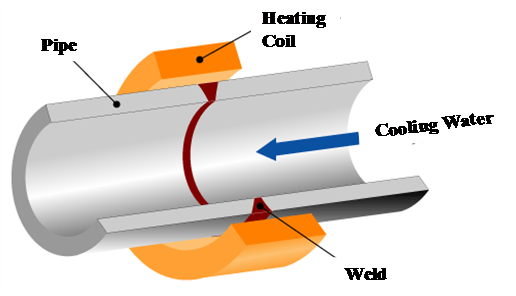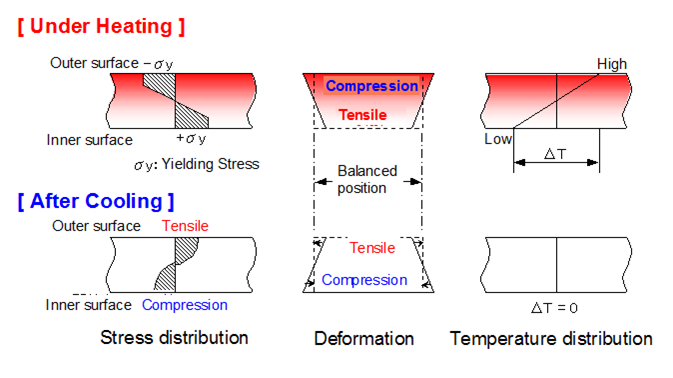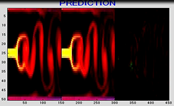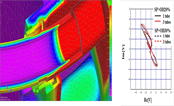IHI Corporation, Satoshi HONGO
Induction Heating Stress Improvement (IHSI) is one of preventive maintenance technologies for stress corrosion crack (SCC) such as primary loop recirculation system of Boiling Water Reactor (BWR). Recently, IHSI has been used a number of BWR plants because it can improve welding residual stress confirmed by past tests. We apply preventive maintenance IHSI for only non crack area, so if there is a crack we have to choose alternative methods (ex, replacement) for preventive maintenance. If this study shows that crack progression is improved by test of IHSI for pipe with crack, it will able to get more choices for repairing strategy and IHSI will be able to applied for one of repairing methods as good for working conditions. It helps to consider maintenance and repairing plans of BWR plant reasonably. In this study, we confirmed the test of IHSI for pipe with crack.
The objective of IHSI is to introduce a large temperature difference between the inner and outer surfaces of a pipe in order to produce sufficient thermal stress to induce some plastic flow and consequently to obtain a compressive residual stress at the inner surface of the pipe. The large temperature difference can be introduced by heating a pipe from the outside with an induction coil while cooling water is supplied simultaneously to the inner surface of the pipe As shown in Fig.1, set the IHSI condition to make liner temperature distribution of the inner pipe thickness. Heating and cooling condition of construction: set the essential variables. During the heating, inner pipe has a tensile stress, then cool-down process it forms compressive stress field. Additionally, in case of the pipe has a crack, crack tip is received tensile loading from inner pipe’s tensile stress. It gives plastic deformation to crack tip without ductile fracture. After the heating, compressive stress field is formed around the crack tip. These effects inhibit progress of crack.

(1)Concept of IHSI

(2)Stress deformation and Temperature distributions Induced by IHSI
Fig.1 Concept of IHSI
Phase 3 : Publicly-accepted Phase
4.1 Confirmation items of test
4.2 Results
Form of crack: EDM initial notch + fatigue crack (deepness: 3/8t, length: inner face 90°)
IHSI condition: three-time heating over the maximum heating temperature 650℃

Fig.2 Cross-sectional observation of the crack tip

Fig.3 Hardness measurements of the crack tip
Form of crack : Deepness: 3/8t, length: inner face 90°by MgCl2
IHSI condition: one-time IHSI treatment (about 1.5 times temperature difference of test parameters ⊿Treq.)
Time of MgCl2 : Crack introduced 120hours, penetrated 120hours after IHSI.
As shown these results, the sample was immersed in MgCl2 for 120 hours similar environment of crack introduce after IHSI. However, the average deepness of crack was 5.25mm before MgCl2. On the other hand, the average deepness of crack was 5.22mm after MgCl2. So it indicated that distinguished deepness of crack wasn’t confirmed.

Fig.4 Ultrasonic Test result before MgCl2

Fig.5 Ultrasonic Test result after MgCl2
Fig.6 shows results of the cross-section observation after MgCl2.
As these results, we confirmed that main crack was generally thick and crack tip was expanded and edged down by IHSI treatment. Additionally, we confirmed that comparatively low deepness crack (named sub-crack) aside from main crack. Those cracks were generally narrow and crack tips were not clear expanded compared with main cracks.
Above that, main crack was reduced stress of the tip, and confirmed that crack progress was inhibited. But, we couldn’t definitely confirm effects of IHSI for low deepness cracks. This time to introduce deep crack, we forcibly changed stress distribution from As welded so that it seemed to be given more cracks in a wide sphere than actual SCC. Therefore, a number of low deepness cracks were submerged by deep main cracks. And it came to be considered that effect of stress reduction wasn’t confirmed clearly by IHSI.
Those results were arisen from strict conditions than actual, but we thought that we couldn’t deny the possibilities of causing such as low deepness cracks after IHSI treatment.

Fig.6 Cross-sectional observation
To confirm efficacy of IHSI around inner pipe’s surface main crack, we checked the existence of new crack from two samples. One is implemented IHSI with EDM cask, and the other is no IHSI treatment sample (As weld).
Test model: Diameter 300A, Thickness 19.75mm, Material SUSF316(LC)
Form of crack: EDM crack (deepness: 3/8t, lengths: inner face 90°)
IHSI condition: one-time IHSI treatment (about 1.5 times temperature difference of test parameters ⊿Treq.)
Time of MgCl2: penetrated 120hours after IHSI.
Fig.7 shows results of PT observations of inner pipe’s surface about As weld and IHSI samples. As shown Fig.7, As weld sample was found new cracks around the weld zone with or without EDM cracks.
Meanwhile, IHSI sample was found new cracks only close to EDM cracks. From these reasons, IHSI treatment improves welding residual stress expect for crack part, and these results indicate that the effect of that IHSI is equal to preventive maintenance one.

Fig.7 Penetrant test results inside surface after MgCl2
Fig.8 shows results of the cross-section observations of EDM crack tip of IHSI and As Welded after MgCl2.
As shown Fig.8, in case of As weld sample was confirmed that small cracks are come up from crack tip, however IHSI sample wasn’t confirmed any cracks such like As weld sample. Therefore, IHSI seems to improve the crack tip stress too.
From those things indicate that effect of IHSI close to cracks tend to fall in, compared to non crack area.

Fig.8 Cross-sectional observation of the crack tip after MgCl2
To confirm efficacy of IHSI aside from inner pipe’s surface crack, we affirmed the existence of new crack. The crack was introduced by MgCl2 after IHSI.
Test Model: Diameter 300A, Thickness 19.75mm, Material SUSF316(LC)
Form of crack: EDM crack (deepness: 3/8t, lengths: inner face 90°)
IHSI condition: Once implement IHSI (about 1.5 times temperature difference of test parameters ⊿Treq.)
Time of MgCl2: 120hours after IHSI.
Fig.9 shows results of observations of inner face PT which was penetrated by MgCl2 after IHSI. As shown Fig.9, new crack wasn’t confirmed around non crack area. However, on part of the crack, we found new crack existence. From this, we can consider that effect of countermeasure IHSI around non crack area is equal to preventive maintenance IHSI.

Fig.9 Penetrant test results inside surface after MgCl2
Fig.10 shows inner face axial welding residual stress of EDM crack part and non crack part on the identical joint. As shown Fig.10, part of crack wasn’t enough improvement to side of compression near the crack area. However, we confirmed the residual stress was improved enough to compression stress about 100 MPa even around the depo.

Fig.10 Residual Stress distribution for inside surface
Mitigation IHSI for pipes with crack was performed successfully at Japanese BWR plant in 2011
- [1]T.Sasayama and S.Hongo “Confirmation test of IHSI for pipe with crack” , 7th Annual Conference of the Japan Society of Maintenology, Omaezaki , pp.379 – 383, July 2010.( in Japanese)






